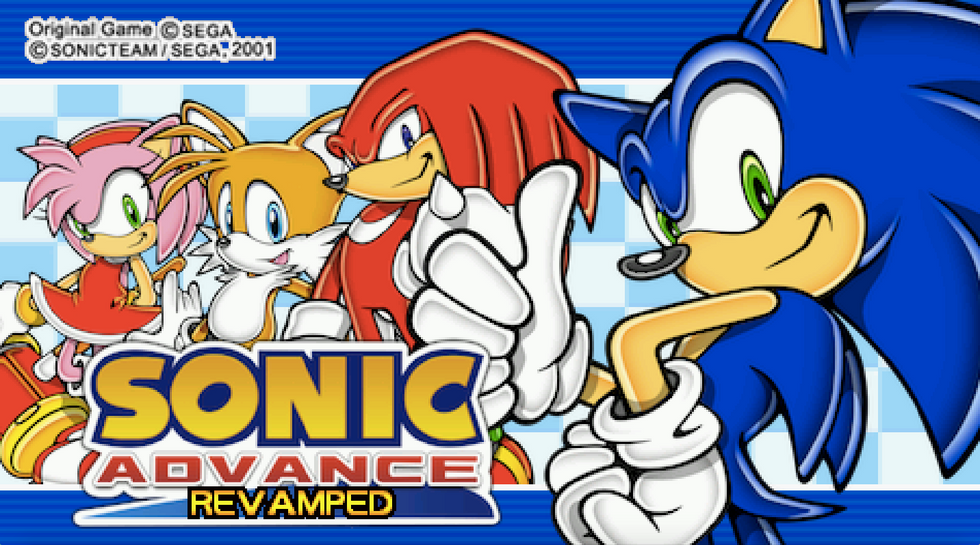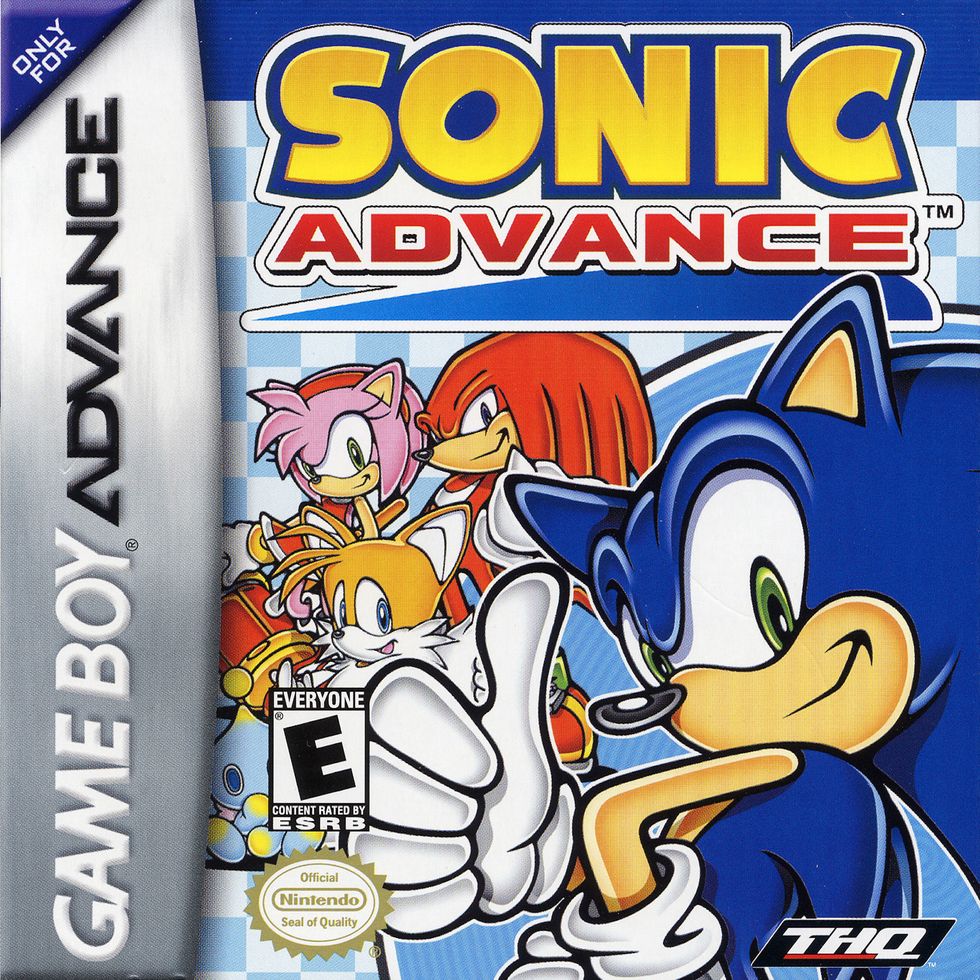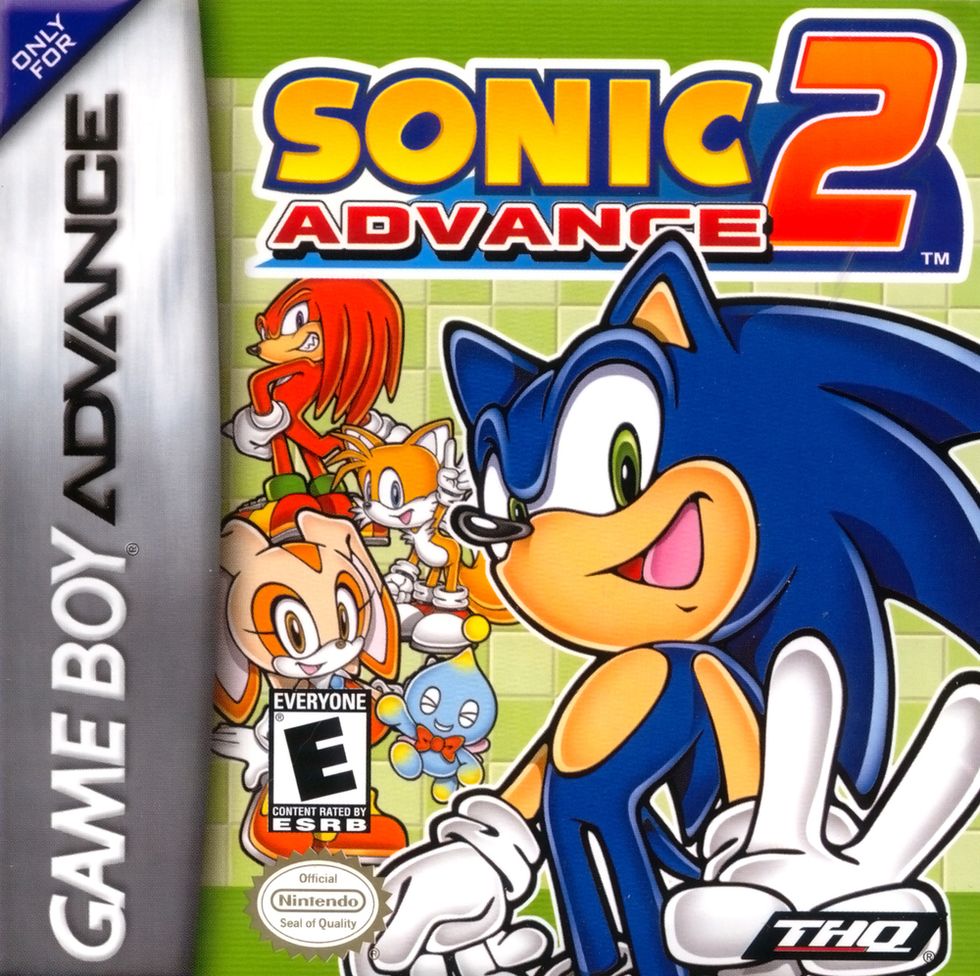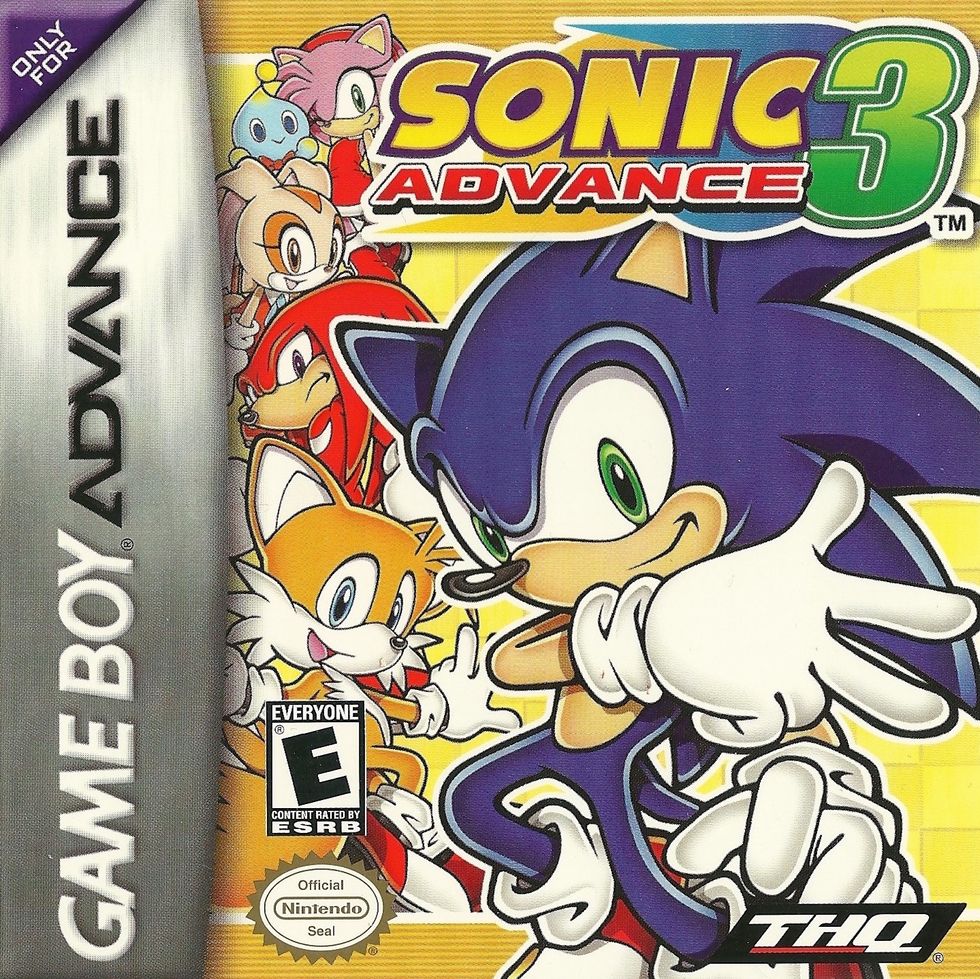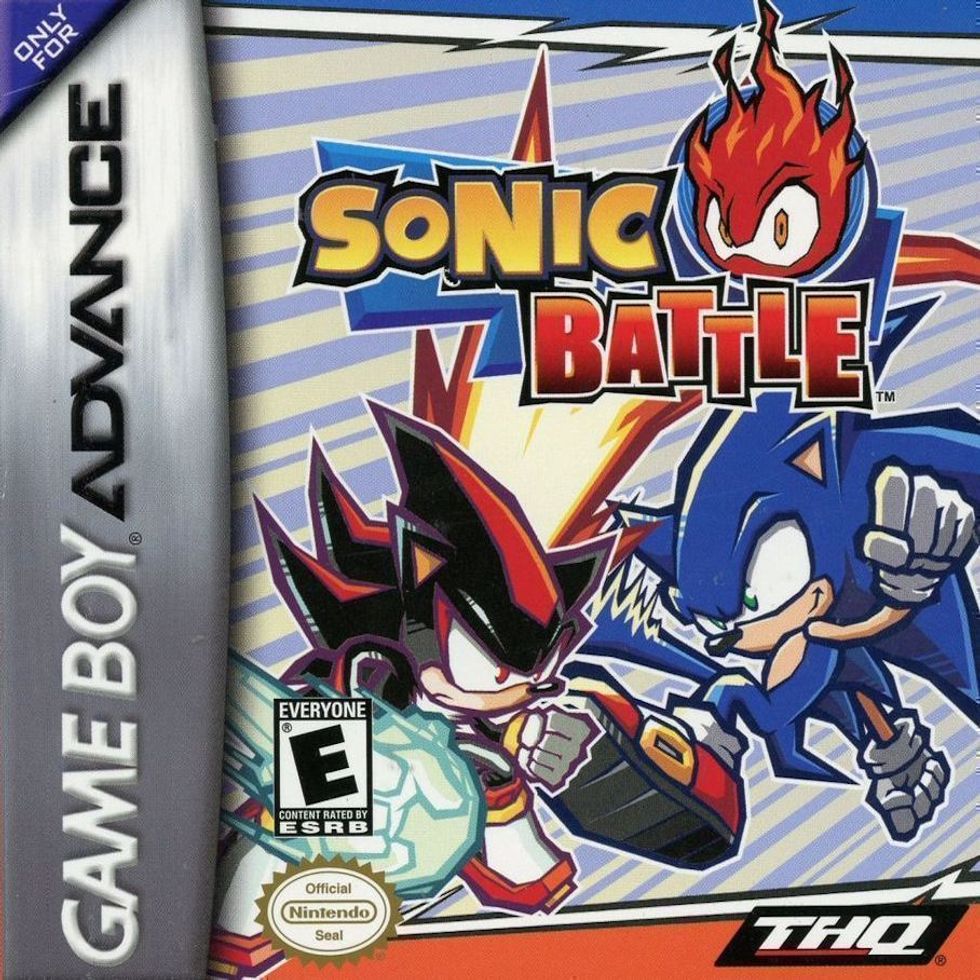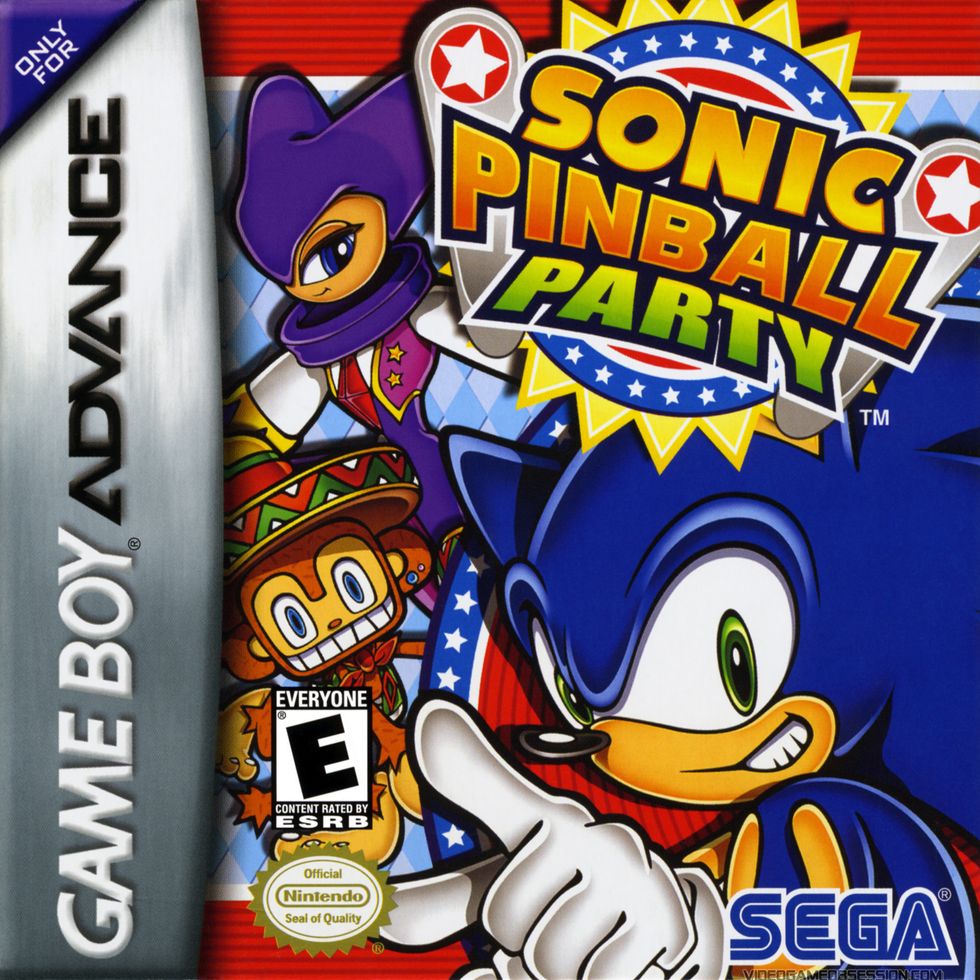So after the release of Sonic Adventure 2 in 2001, the Sega Dreamcast was no more. Especially, with the next generation of consoles being released: Nintendo GameCube, Sony PlayStation 2, and Microsoft Xbox. Sega, as a result, became a third-party developer & publisher. This means that Sonic the Hedgehog not only needs to find a new home with the likes of Sony and Microsoft, but also with Nintendo... Sonic games being released on Nintendo hardware. Yikes! I can hear the fight between Sega and Nintendo fans right now.
Sonic made his debut on the GameCube with ports of Sonic Adventure and Sonic Adventure 2. Then, he also made his debut on the Game Boy Advance, and had 4 more games released for the handheld device.
1) Sonic Advance (2002)
Sonic's latest adventure, Sonic Advance, finds him heading up a cast of four characters. In addition to the speedy blue one, you'll find Miles Tails Prower, Knuckles the Echidna, and Amy Rose. The game's story finds everyone racing to collect the Chaos Emeralds and stop Dr. Eggman's latest evil plan. This time, you'll tear through seven zones, each of which is split up into two acts, and you'll face the standard assortment of enemies along the way. Skilled players who manage to collect the Chaos Emeralds during the game's bonus stages, which are accessed via special springboards hidden in each act, will be able to access a final level that offers a rewarding and challenging boss fight.
Veteran Sonic fans should be right at home with Sonic Advance's gameplay, which stays true to the gameplay of Sonic's classic 16-bit games. You'll guide one of the four playable characters through each zone, collecting rings, avoiding hazards, and dispatching enemies. Your experience in each level will vary slightly depending on which character you choose to play as. While the various acts are the same, the level of difficulty each act offers will be higher or lower depending on the unique abilities of your selected character. For example, being able to fly for short distances as Tails or Knuckles definitely makes some of the precision jumping you'll be forced to do when playing as Sonic or Amy less of a concern. On the other hand, Sonic's momentary invincibility during a jump and the wide arc of attack provided by Amy's hammer offer some advantages when facing some of the other obstacles you'll encounter in the game.
Rating: 5 / 5
2) Sonic Advance 2 (2003)
Sonic Advance 2 is easily the toughest 2D Sonic game ever made, and not just because the Special Rings and Chaos Emeralds are difficult to collect. The boss battles against Eggman's inventions are positively cutthroat. Unlike previous Sonic games, where the action would come to a standstill and you'd fight Eggman in a confined area, the battles in this game occur while you're on the run. In order to attack the weak spot on each of Eggman's machines, you first need to catch up to it, taking care not to get hit by the missiles or spikes tumbling out of the thing. Every time you hit the weak spot, you're knocked back and have to repeat the process again. It isn't an exaggeration to suggest that you'll see the game-over screen a few times before you master the pattern of each boss. At the end of the game, you have to fight them all over again, one after another, in order to reach Eggman's final invention. Sonic Advance 2 is a difficult game to beat, even if you don't care about unlocking the extras.
Even though most of the enhancements here make the game more difficult, they also make it much more interesting than previous Sonic games. In each level, you actually get the sense that you're exploring an area with a variety of features and landmarks. You figure out which characters can access spots the others can't. You come to learn where the enemies are, where the power-ups are, where the Special Rings are, and which tunnels and loops you can access to get through the level faster without bypassing the items you need to collect. Like any good Sonic game, there are still plenty of opportunities to put the pedal to the metal and trigger a chain reaction of turbo ramps, bumpers, and corkscrews.
Also, this is the first game to introduce a new character, Cream the Rabbit.
Rating: 5 / 5
3) Sonic Advance 3 (2004)
Compared to Sonic Advance 2, this game is a bit on the easy side. There are tricky jumps and surprise spike pits in some levels, but you always have the option of going back to previous worlds to gain more extra lives. The attack patterns of the bosses--Dr. Eggman's giant robot contraptions--aren't always clear-cut, but again, extra lives are plentiful. You also don't have to worry about running after bosses before fighting them, which was one of the most irksome things about Sonic Advance 2. For a tougher challenge, you can try to complete the optional Chaos Emerald quest. As is the case in every Sonic game, if you grab the emerald hidden in each world, you can unlock a tougher final boss, view an extended ending, and play briefly as Super Sonic--the beefy gold-tinted hedgehog. Grabbing all seven emeralds is grueling, mainly because the method of collecting them is so convoluted. First, you have to find the Chao pets hidden in each level of the world you're in (there are 10 in each world). Then, you have to go back into the levels and get keys that aren't visible until after the Chaos are found. And finally, you have to use those keys to gain access to a ring-collecting mini-game. After all that, you still need to collect the necessary number of rings in the mini-game in order to earn the Chaos Emerald.
Sonic Advance 3 actually brings something new to the table--a tag-team play mechanic that ultimately enhances the overall product rather than mucking it up. Although Sonic and Tails are the only characters available from the start, the roster expands to include three more characters as you play through the game. What's interesting here isn't that you can choose from any of five different characters, all with their own unique traits and attacks, the interesting part is that you also have to choose a partner character that will follow you around and lend a hand while you play. The pairings you put together can significantly effect (in obvious and not-so-obvious ways) how you deal with the obstacles, enemies, and path choices that you encounter in every level. First off, your main character's speed and hang time, as well as the kinds of ground and midair attacks that it can perform, will change based upon the partner you select. Secondly, you can perform tag tricks (by pushing the R button) that are based upon the abilities of the partner you picked. Tails can launch another character high into the air, Knuckles will leap forward and bash enemies or walls, Cheese, Cream's Chao, can attack enemies and grab rings that aren't within reach, and so on. In all, there are 20 possible pair combinations.
Rating: 5 / 5
4) Sonic Battle (2004)
The easiest way to describe Sonic Battle is to call it a portable version of Super Smash Bros., but instead of using Nintendo's characters to fight your battles, you and your friends can choose any of 10 different characters from the Sonic Adventure series. The goal in this game, much as it is in any knockout game, is to score more knockouts than your opponents by the time the match ends. This isn't a fighting game in the traditional sense, though. The combat system is remarkably simple, and the pace is lightning fast. Most attacks are performed using a combination of the directional pad and the B button, while the A button and the L trigger allow you to jump and guard. There are numerous ways to juggle an opponent in midair, and attacks generally dole out massive amounts of damage.Rating: 4 / 5
5) Sonic Pinball Party (2003)
Sonic Pinball Party is a collection of pinball tables and mini-games based on three of the franchises developed by Sonic Team. The three games turned into pinball boards are Sonic The Hedgehog, Nights Into Dreams, and Samba De Amigo. On the Sonic table, you have to push the ball around loops and targets in order to hatch Chao creatures, collect gold rings, and bring about the presence of Dr. Eggman--whom you defeat by ramming into the underside of his floating chariot, just like it's done in the Sonic the Hedgehog games. The Nights table emphasizes loops much more than the Sonic table, which is in keeping with the general theme of the Nights game, which was originally available for the Sega Saturn. By landing the ball in the Ideya Capture, you can collect spheres that will allow you to face off against the boss, the Nightmarens, in a darker version of the main table. The last table in the game is based on Samba De Amigo, a rhythm game that was originally released on the Sega Dreamcast console and that came with its own maracas attachment. Unlike in the other tables, where you fight boss characters in order to move on to the next stage, the main goal in the Samba table is to activate a rhythm bonus game where you press buttons in an effort to shake maracas in time with music.
Rating: 3.5 / 5

